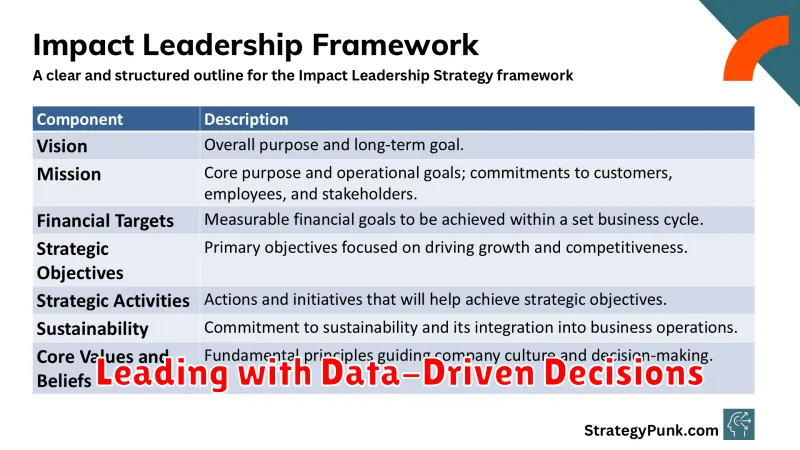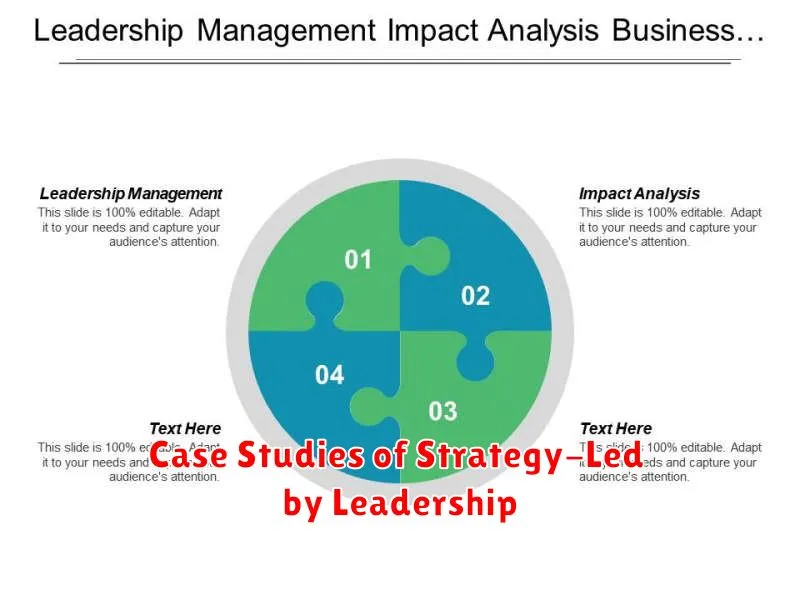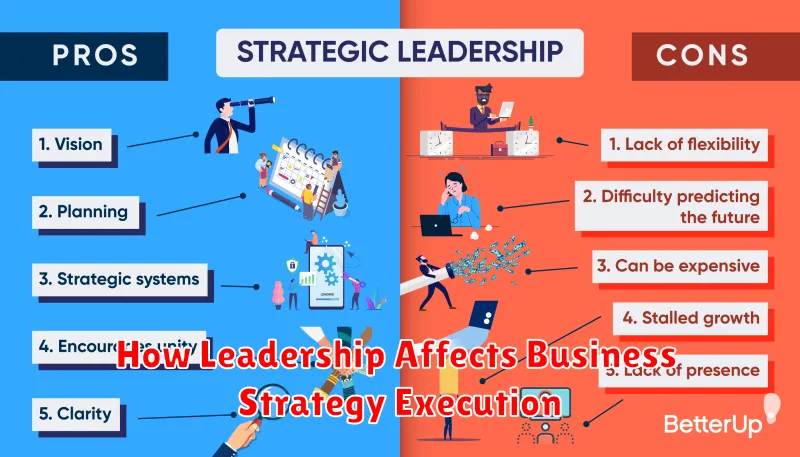Leadership plays a pivotal role in the successful execution of business strategy. A strong leadership team can effectively communicate the strategy, inspire and motivate employees, allocate resources efficiently, and navigate challenges that inevitably arise during the implementation process. Conversely, poor leadership can derail even the most well-crafted business strategies, leading to confusion, lack of commitment, and ultimately, failure to achieve desired outcomes. This article will explore the multifaceted relationship between leadership and business strategy execution, examining how different leadership styles, qualities, and actions can significantly impact a company’s ability to translate strategic plans into tangible results.
From setting the strategic vision to fostering a culture of accountability, leadership influences every stage of business strategy execution. Understanding the crucial link between leadership and strategy execution is essential for organizations seeking sustained growth and success. We will delve into specific examples of how effective leadership drives strategy execution, while also analyzing the pitfalls of ineffective leadership. This article will provide valuable insights for business leaders at all levels, offering practical guidance on how to strengthen their leadership capabilities to effectively execute business strategies and achieve organizational objectives.
Role of Leadership in Strategic Direction
Leadership plays a critical role in defining and communicating strategic direction. Effective leaders establish a clear vision that aligns with the organization’s goals and values.
This vision serves as a roadmap, guiding decision-making at all levels. Leaders also foster a culture of adaptability and innovation, enabling the organization to respond effectively to changes in the external environment.
By setting the strategic course and empowering employees to contribute, leadership ensures the organization’s efforts are focused and directed towards achieving its long-term objectives.
Setting Vision and Inspiring Execution
Vision acts as the guiding star for strategy execution. A clearly articulated vision provides a shared understanding of the desired future state of the organization. This shared understanding is critical for aligning efforts and motivating individuals towards a common goal.
Leaders play a vital role in translating the vision into actionable steps. This involves effectively communicating the vision, ensuring it resonates with employees at all levels, and fostering a culture of commitment and accountability.
Inspiration fuels execution. Leaders must inspire their teams to embrace the vision and dedicate themselves to achieving strategic objectives. This requires strong communication, demonstrable passion, and the ability to cultivate a sense of purpose and ownership among team members.
Empowering Teams Through Autonomy
Autonomy plays a crucial role in successful strategy execution. When teams are empowered to make decisions and own their work, they become more invested in the outcome. This sense of ownership fosters increased engagement and motivation, leading to improved performance and innovation.
Leaders can foster autonomy by clearly defining goals and expectations, then stepping back to allow teams to determine the best path forward. Providing the necessary resources and support is essential, while also creating a safe space for experimentation and learning from mistakes. This approach cultivates a culture of trust and accountability, empowering teams to take calculated risks and drive the strategy forward.
Communication as a Core Strategy Driver
Effective communication plays a crucial role in successful strategy execution. Leaders must clearly articulate the strategic vision, goals, and individual roles to ensure everyone is aligned.
Consistent communication builds understanding and buy-in, fostering a sense of shared purpose. This shared understanding empowers teams to make informed decisions that support the overall strategy. Transparency in communication also builds trust and allows for proactive problem-solving.
Without clear and consistent communication, even the most well-defined strategies can falter. Misunderstandings, conflicting priorities, and a lack of motivation can hinder progress and ultimately lead to failure in achieving strategic objectives.
Leading with Data-Driven Decisions

In today’s complex business landscape, effective leadership relies heavily on data-driven decisions. Strategic choices must be grounded in factual insights rather than intuition or guesswork.
Leaders who prioritize data analysis gain a competitive advantage. They can identify emerging trends, understand customer behavior, and optimize resource allocation more effectively.
By leveraging data analytics, leaders can measure the impact of strategic initiatives and make necessary adjustments in real-time, ensuring successful execution of business strategies.
Removing Barriers to Strategy Success
Effective strategy execution hinges on identifying and mitigating roadblocks. Leadership plays a crucial role in this process. Common obstacles include poor communication, lack of resources, inadequate training, and resistance to change.
Leaders must foster a culture of open communication to ensure everyone understands the strategy and their role in its success. Resource allocation should align with strategic priorities. Investing in training and development equips employees with the necessary skills. Finally, addressing resistance to change through clear communication and demonstrating the benefits of the new strategy is vital.
Leadership Styles and Organizational Fit
Different leadership styles significantly impact how effectively a business strategy is executed. Choosing the right leadership style for a given organization and its specific strategic goals is crucial. A mismatch can lead to confusion, decreased morale, and ultimately, poor performance.
A transformational leader, for example, may excel at inspiring innovation and change, making them suitable for organizations pursuing disruptive strategies. Conversely, a transactional leader, focused on clear processes and performance metrics, might be more effective in stable environments implementing efficiency-driven strategies.
Organizational culture also plays a key role. A hierarchical culture may thrive under a directive leadership style, while a flatter, more collaborative culture might benefit from a democratic or participative approach. Finding the right fit between leadership style, organizational culture, and strategic objectives is a key determinant of successful strategy execution.
Feedback Loops from Team to Leader
Effective strategy execution relies on robust communication, including upward feedback. Establishing clear feedback loops from the team to the leader is crucial. These loops provide the leader with essential information regarding on-the-ground realities, potential roadblocks, and the team’s perception of the strategy’s viability.
Feedback can take many forms, including regular check-ins, anonymous surveys, and team meetings dedicated to strategy discussion. Open communication channels encourage teams to voice concerns, suggest improvements, and highlight successes. This information allows leaders to make informed adjustments, ensuring the strategy remains relevant and effective.
Developing Next-Gen Leaders
Cultivating future leaders is crucial for sustained organizational success. Next-gen leaders must be equipped to navigate the complexities of a rapidly evolving business landscape. This requires a proactive and strategic approach to leadership development.
Key focus areas include fostering adaptability, promoting innovation, and building a strong digital skillset. Programs should incorporate experiential learning, mentorship opportunities, and exposure to diverse business challenges.
By investing in the development of next-gen leaders, organizations can ensure they have the talent pipeline necessary to execute future business strategies effectively.
Case Studies of Strategy-Led by Leadership

Effective leadership plays a crucial role in successful strategy execution. Examining real-world examples highlights this impact.
Example 1: Transformational Leadership
A CEO of a struggling tech company implemented a visionary strategy focusing on innovation. Their inspirational leadership motivated employees, leading to the development of groundbreaking products and a revitalized market position.
Example 2: Strategic Alignment
A retail company facing declining sales adopted a customer-centric strategy. Leadership ensured alignment across departments, from marketing to customer service, resulting in improved customer satisfaction and increased sales.

